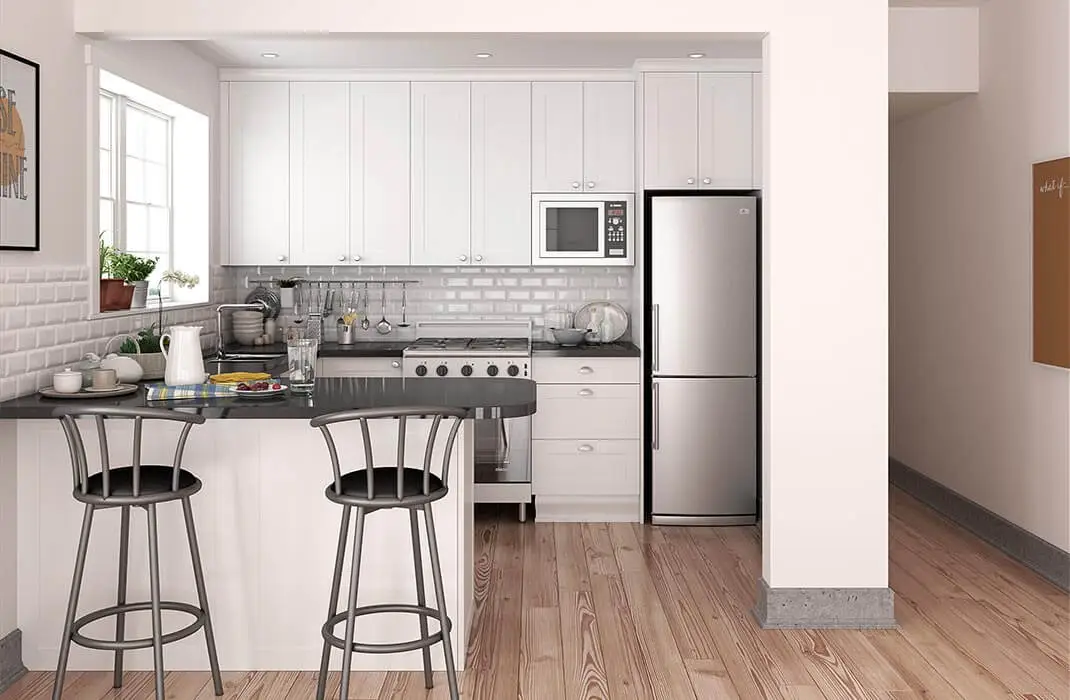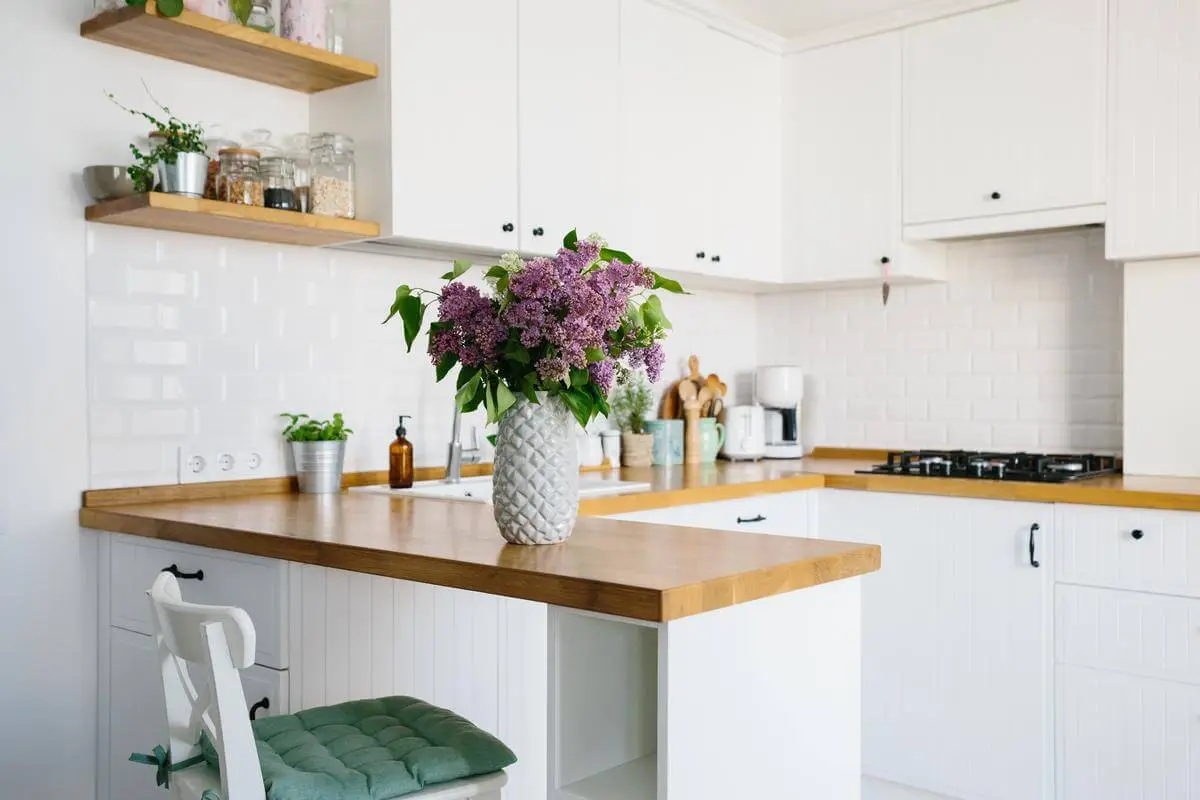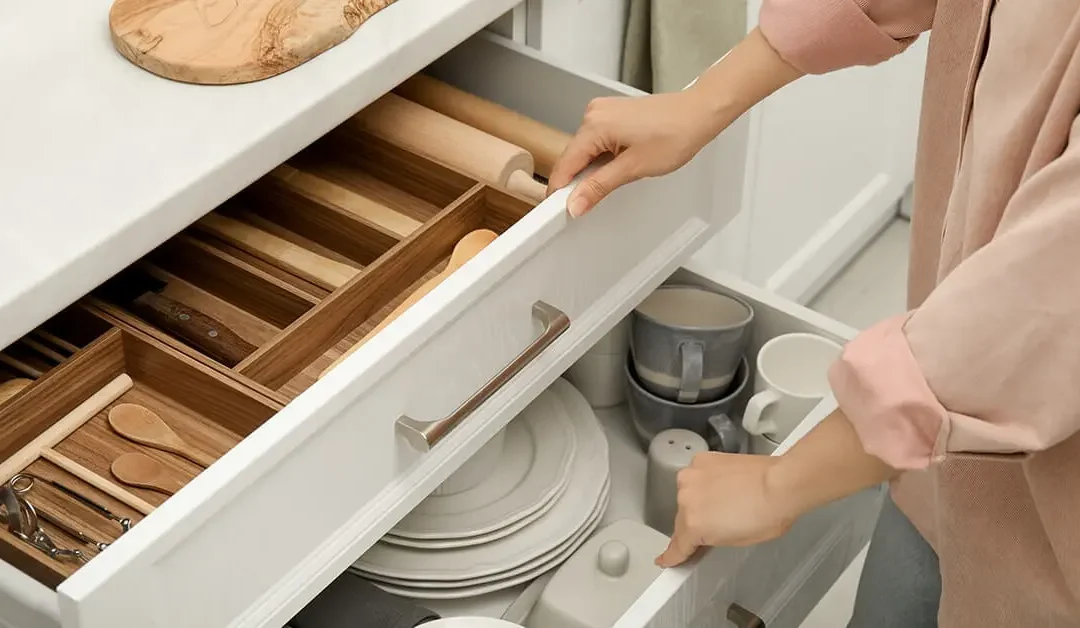The kitchen is often the heart of the home, but it can also be one of the most cluttered and disorganized areas. Limited space can make it difficult to find what you need when cooking or entertaining, causing unnecessary stress and frustration.
Understanding the importance of kitchen space is crucial in creating a functional and efficient cooking area. A well-organized kitchen not only makes your daily meal preparation easier but also enhances the overall aesthetic appeal of your home.
At Project Neat, we will explore various ways to configure your kitchen layout for maximum space utilization. We will discuss the importance of a good kitchen layout and explore common kitchen layouts that can help you make the most of your available space.
Effective storage tips will also be shared to help you optimize the storage capacity in your kitchen. From utilizing wall and ceiling space to using cabinet and drawer organizers, we will provide practical solutions to keep your kitchen organized and clutter-free. We will also discuss the benefits of incorporating multi-purpose furniture and appliances to maximize functionality without sacrificing space.
Maintaining a clutter-free kitchen is essential for a streamlined and stress-free cooking experience. We will delve into the importance of regular decluttering and efficient use of space to ensure that everything has its place. Additionally, we will explore the role of minimalism in kitchen space and how it can contribute to a more functional and visually appealing environment.
Adapting storage solutions based on kitchen size is crucial to make the most of the available space. We will provide tailored storage tips for small kitchens, as well as strategies for maximizing space in large kitchens. For those with medium-sized kitchens, we will offer storage solutions that strike the perfect balance between functionality and space optimization.
Maximizing kitchen space has a significant impact on the efficiency and aesthetics of your kitchen. By implementing the storage tips and strategies discussed in this blog post, you can transform your kitchen into a well-organized and visually pleasing space that truly reflects your personal style. Get ready to embrace a clutter-free and functional kitchen that enhances your culinary experience. Stay tuned for our upcoming blog posts on kitchen organization and design!
Understanding the Importance of Kitchen Space
The importance of kitchen space cannot be overstated when it comes to creating a functional and efficient cooking area. A well-utilized kitchen space not only enhances your cooking experience but also contributes to the overall organization and aesthetic appeal of your home. Understanding the significance of kitchen space will help you prioritize and optimize the utilization of every inch available.
- Efficient Workflow: An adequately designed kitchen space allows for a smooth and efficient workflow. When everything is within easy reach and well-organized, you can move seamlessly from one task to another without unnecessary steps or wasted time. This ensures that your cooking process is streamlined and enjoyable.
- Safety and Comfort: Sufficient kitchen space is essential for ensuring safety and comfort. With ample room to maneuver, you can avoid accidents and injuries that may occur due to cramped spaces or overcrowded countertops. It also allows multiple people to work in the kitchen simultaneously without feeling crowded or restricted.
- Storage Capacity: A well-designed kitchen space provides ample storage capacity for all your cookware, utensils, appliances, and pantry items. Proper storage solutions help keep your kitchen organized and clutter-free, making it easier to find what you need when you need it. Maximizing storage space is essential for small kitchens, where every inch counts.
- Visual Appeal: A well-organized and visually appealing kitchen space adds to the overall aesthetics of your home. When items are stored neatly and displayed attractively, it creates a welcoming and pleasant atmosphere. By optimizing your kitchen space, you can create a space that not only functions well but also looks beautiful.
- Resale Value: A kitchen with ample space and efficient storage solutions is highly desirable for potential homebuyers. Maximizing kitchen space and incorporating smart storage solutions can significantly increase the resale value of your home. It is an investment that pays off both in terms of functionality and property value.
Overall, understanding the importance of kitchen space is the first step in creating a well-organized and efficient cooking area. By prioritizing efficient workflow, safety, storage capacity, visual appeal, and resale value, you can make informed decisions when it comes to configuring your kitchen layout and implementing storage solutions. If these are not steps you feel comfortable taking on your own, you can also hire kitchen organization services like us here at Project Neat to help ensure your kitchen feels, looks, and functions the way you’ve always wanted. In the following sections, we will explore various strategies and tips to help you maximize the utilization of your kitchen space.
Configuring Your Kitchen Layout for Maximum Space
Configuring your kitchen layout is crucial for maximizing space utilization and creating an efficient and functional cooking area. A well-designed kitchen layout not only optimizes space but also enhances workflow, accessibility, and overall aesthetics. In this section, we will discuss the importance of a good kitchen layout, explore common kitchen layouts, and provide guidance on choosing a layout that maximizes space.
Importance of a Good Kitchen Layout
- Efficient Workflow: A good kitchen layout ensures a smooth and efficient workflow by organizing key elements in a logical sequence. It takes into account the natural flow of food preparation, cooking, and cleaning, minimizing unnecessary steps and maximizing productivity.
- Accessibility: An effective kitchen layout ensures that everything is easily accessible, reducing the need to reach or stretch for items. It considers the placement of appliances, cabinets, and workstations to facilitate seamless movement and convenience during cooking.
- Safety: A well-designed kitchen layout prioritizes safety by minimizing potential hazards and providing clear pathways. It ensures that appliances are appropriately spaced, sharp objects are stored securely, and there are no obstacles that could cause accidents or injuries.
- Aesthetics: A good kitchen layout enhances the overall aesthetics of the space, creating a visually appealing environment. It considers the balance between functionality and design, incorporating elements such as color schemes, lighting, and materials that complement the overall style of your home.

Common Kitchen Layouts
- Galley Kitchen: This layout features two parallel countertops with a walkway in between. It maximizes space efficiency and is ideal for small kitchens or narrow spaces. It provides easy access to all areas of the kitchen, allowing for a streamlined workflow.
- L-Shaped Kitchen: In this layout, countertops and cabinets are arranged in an L-shape, utilizing two adjacent walls. It provides ample counter space and storage while maintaining an open feel. It is suitable for both small and large kitchens.
- U-Shaped Kitchen: This layout consists of three walls of cabinets and countertops, forming a U-shape. It offers plenty of storage and workspace and provides an efficient workflow with easy access to all areas. It is ideal for larger kitchens.
- Island Kitchen: This layout incorporates an island in the center, providing additional workspace, storage, and a gathering area. It is versatile and can be combined with other kitchen layouts to maximize space utilization and functionality.
Choosing a Layout that Maximizes Space
When choosing a kitchen layout that maximizes space, consider the following factors:- Size and Shape of the Kitchen: Assess the size and shape of your kitchen to determine which layout will make the most efficient use of the available space.
- Functionality and Workflow: Consider how you use your kitchen and prioritize functionality. Choose a layout that supports your cooking style and allows for a seamless workflow.
- Storage Needs: Evaluate your storage requirements and choose a layout that provides ample cabinet and pantry space to accommodate your needs.
- Aesthetic Preferences: Consider your personal aesthetic preferences and choose a layout that aligns with the overall style of your home.
Effective Storage Tips for Your Kitchen
Effective storage is key to maximizing the space in your kitchen and ensuring that everything is well-organized and easily accessible. In this section, we will provide a range of storage tips to help you optimize your kitchen space and keep it clutter-free.Utilizing Wall and Ceiling Space
- Wall-mounted Shelves and Racks: Install wall-mounted shelves and racks to maximize vertical storage. These can be used to store frequently used items such as cookbooks, spices, and utensils, keeping them within reach while freeing up countertop space.
- Hanging Pots and Pans: Utilize ceiling or wall-mounted pot racks to store your pots and pans. This not only saves cabinet space but also adds a decorative element to your kitchen.
- Magnetic Strips: Attach magnetic strips to the wall for easy storage of metal utensils such as knives and metal spice containers. This not only saves drawer space but also keeps your tools organized and within reach.
- Pegboards: Install a pegboard on your kitchen wall to hang various kitchen tools, including measuring cups, cutting boards, and spatulas. This customizable storage solution allows you to rearrange and optimize your kitchen space according to your needs.
Using Cabinet and Drawer Organizers
- Pull-Out Shelves: Install pull-out shelves in your cabinets to maximize storage and easily access items stored at the back. These shelves allow you to see and retrieve items without having to rummage through the entire cabinet.
- Drawer Dividers: Use drawer dividers to keep your utensils, silverware, and small kitchen gadgets neatly organized. This prevents them from becoming a jumbled mess and makes it easier to find what you need.
- Vertical Plate Racks: Incorporate vertical plate racks in your cabinets to store plates and lids vertically, saving space and making it easier to access them.
- Stackable Containers: Use stackable containers or bins to organize your pantry items such as grains, snacks, and baking supplies. This not only maximizes space but also keeps your pantry neat and tidy.
Incorporating Multi-Purpose Furniture and Appliances
- Kitchen Island with Storage: Choose a kitchen island with built-in storage to maximize functionality. This provides additional countertop space and allows you to store items such as cookbooks, small appliances, and kitchen linens.
- Rolling Carts: Utilize rolling carts with shelves or drawers to create additional storage that can be easily moved around based on your needs. These carts can be used to store items like pots and pans, baking supplies, or even as a portable pantry.
- Appliance Garages: Install appliance garages or cabinets with roll-up doors to keep small appliances like toasters, blenders, and coffee makers hidden when not in use. This frees up valuable countertop space and keeps your kitchen looking clean and organized.
- Under-Sink Storage: Make use of the space under your sink by installing pull-out drawers or shelves. This area can be used to store cleaning supplies, garbage bags, and other essentials, keeping them easily accessible yet out of sight.
Maintaining a Clutter-Free Kitchen
Maintaining a clutter-free kitchen is essential for a streamlined and stress-free cooking experience. A cluttered kitchen not only hinders your ability to find what you need but can also create a chaotic and uninviting environment. In this section, we will explore strategies for regular kitchen decluttering, efficient use of space, and the role of minimalism in maintaining a clutter-free kitchen.Regular Decluttering
- Purge Unused Items: Regularly go through your kitchen and identify items that you no longer use or need. Donate or discard these items to free up valuable space and reduce clutter.
- Clear Countertops: Keep your countertops clear of unnecessary items. Only have essential appliances and frequently used items on display. Store less frequently used appliances and utensils in cabinets or designated storage areas.
- Sort and Organize: Establish a system for organizing your kitchen items. Group similar items together and assign them dedicated storage spaces. This makes it easier to find what you need when you need it and minimizes clutter.
- Implement the “One In, One Out” Rule: For every new item you bring into your kitchen, consider removing an old or unused item. This helps prevent accumulation of unnecessary items and ensures that your kitchen remains clutter-free.
Efficient Use of Space
- Optimize Cabinet and Drawer Space: Utilize drawer dividers, shelf risers, and stacking shelves to maximize storage capacity in your cabinets. Make use of vertical space by installing hooks or hanging baskets on the inside of cabinet doors.
- Utilize Empty Wall Space: Install wall-mounted shelves, hooks, or hanging rails to utilize empty wall space for additional storage. This can be used to hang pots and pans, display cookbooks, or store frequently used utensils.
- Make Use of Corner Space: Install rotating corner shelves or pull-out organizers to maximize storage in corner cabinets. This allows for easy access to items that would otherwise be difficult to reach.
- Invest in Space-Saving Storage Solutions: Consider investing in storage solutions specifically designed to maximize space in the kitchen, such as stackable containers, magnetic spice racks, or collapsible storage containers.
The Role of Minimalism in Kitchen Space
- Simplify and Streamline: Embrace a minimalist approach by keeping only essential items in your kitchen. Eliminate duplicates, unused gadgets, and excess cookware to create a clutter-free and functional space.
- Quality Over Quantity: Prioritize quality kitchen tools and appliances that are versatile and durable. This reduces the need for multiple items and ensures that you have what you need without unnecessary clutter.
- Clear Visuals: Opt for clean and uncluttered visual aesthetics in your kitchen. Choose a minimalist color scheme, utilize clean lines, and keep surfaces free of unnecessary decorations or excessive knick-knacks.
- Regular Maintenance: Regularly assess your kitchen for any unnecessary items or clutter that may have accumulated. Set aside time for periodic decluttering sessions to maintain a minimalist and clutter-free kitchen.

Adapting Storage Solutions Based on Kitchen Size
Adapting storage solutions based on the size of your kitchen is crucial to maximize space utilization and ensure that your storage needs are met. Whether you have a small, large, or medium-sized kitchen, there are specific strategies and tips that can help you optimize storage capacity. In this section, we will provide tailored storage tips for small kitchens, strategies for maximizing space in large kitchens, and storage solutions for medium-sized kitchens.Storage Tips for Small Kitchens
- Utilize Vertical Space: Maximize vertical space by installing wall-mounted shelves, hooks, or racks. This allows you to store frequently used items within reach while keeping countertops clear.
- Invest in Compact Appliances: Opt for compact appliances that are designed to save space, such as slim refrigerators, combination microwave-ovens, or under-counter dishwashers. These appliances allow you to enjoy the functionality you need without sacrificing valuable space.
- Utilize Cabinet Doors: Make use of the inside of cabinet doors by installing hooks or small shelves. This provides additional storage for items like measuring spoons, pot holders, or small utensils.
- Opt for Multi-Purpose Furniture: Choose multi-purpose furniture, such as kitchen islands with built-in storage or tables with shelves underneath. These pieces provide extra storage while serving as functional workspaces.
Maximizing Space in Large Kitchens
- Create Zones: Divide your large kitchen into different functional zones, such as cooking, prepping, and storage areas. This helps to maximize efficiency and keep everything well-organized.
- Consider Walk-In Pantry: If space permits, consider incorporating a walk-in pantry to store dry goods, small appliances, and bulk items. This frees up cabinet space for other kitchen essentials.
- Install Deep Drawers: Opt for deep drawers instead of traditional cabinets to store pots, pans, and larger kitchenware. This provides better accessibility and organization.
- Add a Kitchen Island: Install a kitchen island to provide additional storage and workspace. Choose an island with cabinets, shelves, or drawers to maximize storage capacity.
Storage Solutions for Medium-Sized Kitchens
- Install Pull-Out Pantry: Consider installing a pull-out pantry cabinet to optimize storage for canned goods, spices, and other pantry items. This makes items easily accessible while maximizing space.
- Use Wall-Mounted Racks: Install wall-mounted racks or magnetic strips to store frequently used utensils, knives, or spice containers. This keeps them within reach while freeing up drawer space.
- Optimize Corner Cabinets: Utilize corner cabinets with rotating shelves or pull-out organizers to make the most of corner space. This ensures efficient use of storage capacity.
- Invest in Modular Storage Systems: Consider investing in modular storage systems that can be customized to fit your specific needs. These systems allow you to adjust shelving and compartments according to your storage requirements.
The Impact of Maximizing Kitchen Space with Project Neat
Maximizing kitchen space is not only about creating a well-organized and functional cooking area but also about enhancing your overall lifestyle. By implementing effective storage tips, configuring your kitchen layout, and maintaining a clutter-free environment, you can experience the following benefits:- Efficiency and Productivity: A well-utilized kitchen space allows for efficient workflow, making meal preparation and cooking tasks more streamlined and enjoyable. With everything organized and within reach, you can save time and energy in the kitchen.
- Accessibility and Safety: By optimizing storage solutions and configuring your kitchen layout, you can ensure that everything is easily accessible and reduce the risk of accidents or injuries caused by clutter or lack of space.
- Aesthetics and Visual Appeal: Maximized kitchen space creates a visually appealing environment that adds to the overall aesthetics of your home. A clutter-free and well-organized kitchen enhances the overall ambiance and makes your cooking experience more enjoyable.
- Functionality and Flexibility: Effective storage solutions, such as utilizing wall and ceiling space or incorporating multi-purpose furniture, increase the functionality and flexibility of your kitchen. You can make the most of your available space and adapt it to your changing needs.
- Property Value: A well-designed and organized kitchen with maximized space is highly desirable for potential homebuyers. By investing in storage solutions and optimizing your kitchen’s layout, you can increase the resale value of your home.

